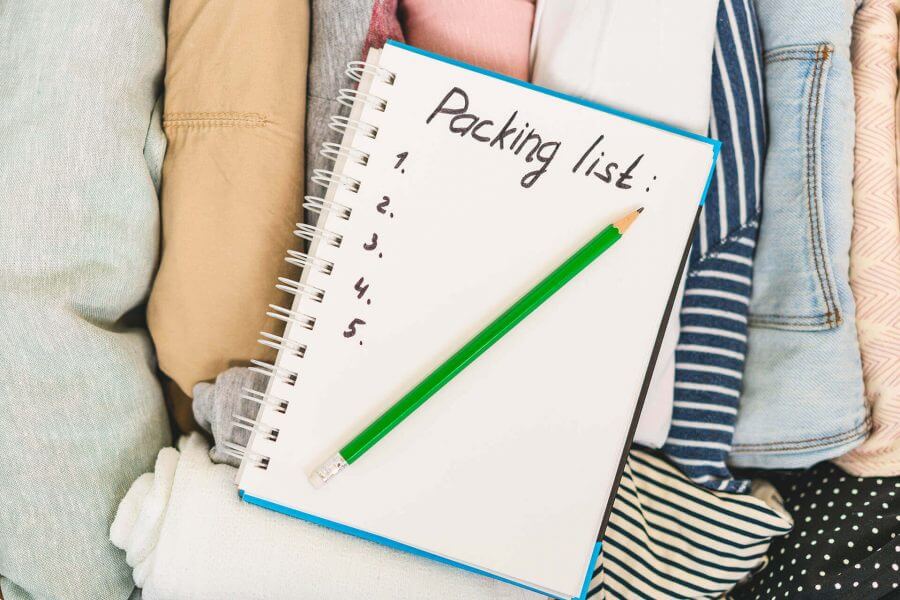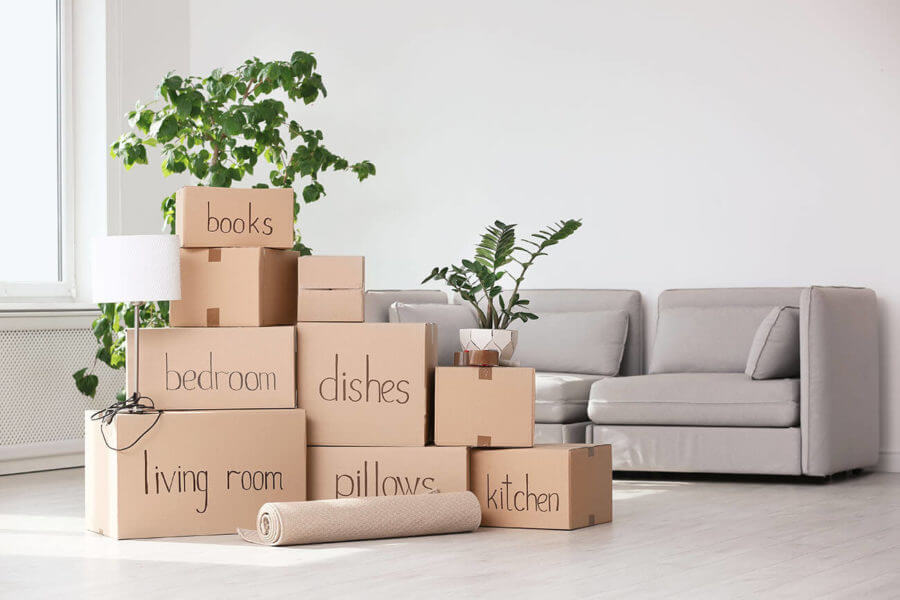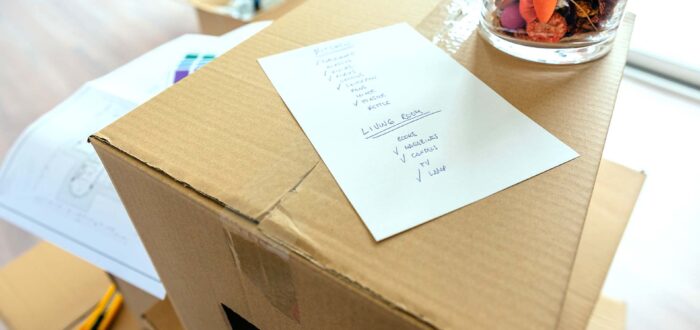

Amazing Moving Tips That Will Make Your Relocation a Breeze
Posted in Moving Tips & Tricks on August 20, 2021
The best way to relocate safely and without panic is, firstly, to take a deep breath. After you convince yourself you got this, the second thing to do is follow moving tips that are sure to help you prepare for and maybe even enjoy the process of cross-country moving.
During last year, 26% of Americans considered relocating, and their reason to move was the ongoing pandemic. While many had to reschedule or delay relocation during the coronavirus, they didn’t change their minds in the meantime; they listed lower costs of living and the desire to be in a less populated area as reasons. Whether you feel the same or something completely different motivates you to move, the advice for relocating safely applies in any situation.
How Can I Make Moving Out Easier?
The number one solution for making the relocation process easier is not to do it alone. If you’re relocating with pets, it would be great to have someone to pet-sit when you start taking boxes out of the house. If you can’t get friends and family on board, try hiring cross-country moving services since they know how to pack and move efficiently.
The other thing that can make relocating much easier is determining a relocation budget and sticking with it. It may be tempting to book a bigger truck or buy loads more packaging supplies just in case, but it’s better not to waste money. Additionally, buying more than you need is in direct contradiction to the major rule of decluttering before packaging, and stuff could get damaged in a bigger truck because they’re free to roam around the trailer during transport.

Moving Tips to Follow Before the Move
Moving cross-country isn’t just packaging and getting supplies; there’s a lot more that goes on behind the scenes a long time before the move. You can read long-distance moving advice that tells you how to pack shoes and recognize potential relocation scams, but we bet you don’t hear about utilities and inventory lists that often. Before anything happens on relocation day, you have to think about the technicalities – canceling the existing utility bills and setting up new ones in your other place.
Cancel and Set Up Utilities About a Month Before Moving Out
Transferring utilities to another address or person is a task on a scale of difficult to impossible. It’s better to simply cancel and then set up and register your other address just before you move in. You can cancel about a month before leaving the old place, so the utilities last for the next four weeks. In the same way, you can set them up in advance and have everything ready when you arrive.
If you’re not sure what falls under utilities, it’s things such as:
- Electricity,
- Water,
- Gas,
- Cable and Internet,
- Sewage and sanitation services,
- Waste disposal.
Create a Household Inventory Checklist
Creating a household inventory list gives you insight into the amount, the type, and the size of the stuff you have at home. This information will come in handy when you start gathering supplies to package the stuff and when you start decluttering. Let’s be realistic – there’s no chance you can (or should) bring everything that exists in your house. This presents the opportunity to figure out what should you move first when moving.
Another reason why inventory lists are helpful is the cross-country relocation crew you hire will determine the prices of their packing services according to the list of items you provide. Because of this, they know how much packaging is required, and you’ll know how much money to set aside for the costs of movers.
Hire Long Distance Movers a Few Weeks In Advance
Hiring long distance movers to help you out may seem contradictory to saving money, but it’s worth every penny. It’ll mean less stress both on relocation day and the entire period before it. You would have to pack some stuff on your own and declutter so that you wouldn’t be completely idle, but they’d do most of the hard work when packaging and loading the relocation truck.
If you don’t feel like decluttering or aren’t ready for it just yet, there’s another benefit to hiring a relocation company that you may not have by yourself – storage services. One of the main parts of relocation costs is accommodating your things in storage units (which you can use for free for a month,) and it’s a great option to have. Pair that with relocation insurance, and you’ll have the total package.

How to Say Goodbye to the Stuff You Don’t Need
As difficult as it may be, the best way to organize your move is to get rid of stuff you don’t need. Dedicate a section to how you can get rid of them in your relocation binder so you don’t forget this crucial step over time. Our advice is to donate or sell any unwanted items in good condition; don’t leave them in storage since you probably won’t use them again.
Items that aren’t in great shape can be recycled in a nearby disposal center or simply given to waste disposal companies to deal with them. You can always find ways to responsibly get rid of the stuff you’ve decluttered and feel better about deciding to throw everything away.

Packing Tips for Moving Cross-Country – How to Utilize Supplies to Package Efficiently
You probably wonder, “when should I start packing to move” and the short answer is – as soon as you get all the relocation essentials. Gathering packaging supplies isn’t tricky, but for the move to go as cheaply as possible, you’ll have to dig around and use relocation hacks to get everything required for packaging. If you don’t want or don’t have time to put into scavenging for cheaper supplies, that’s okay. Purchasing them isn’t that expensive.
Find the Right-Sized Boxes for Packing All Types of Inventory
When you’re stuck with figuring out how to pack glasses, or better yet, how to pack pots and pans, a lot can go through your mind – from worrying about breaking the glasses to frustration on how exactly to package a pan into a box. The secret lies in picking the right-sized box for each type of cargo.
If you use a box that’s too big, the items inside will have too much space between them, and they’ll bump into each other, which is not the ideal scenario when you have fragile stuff such as glasses. However, the possibility of breakage is just the same in a box that’s too small. If you cram too many things into a smaller container, it won’t hold that well. You can try fitting the cargo into the boxes as a test before officially wrapping and packaging it.
Don’t Forget to Wrap the Cargo With Some Protective Layers
When packaging fragile items, you have to figure out how to protect them from breaking during transport. Each item needs to be tightly wrapped into protective material, such as packing paper or bubble wrap. These are commonly used materials by professionals from relocation companies, so why not give them a try?
When you wrap glasses, put some of the wrapping material into them to protect the glass inside and out. In wrapping pots and pans, just be sure to cover the insides, especially if they’re from non-stick materials. You don’t want them to get scratched in a box, of all places, not after protecting them for so long. Additionally, utilize the extra wrapping materials for padding since filling the gaps between cargo and cushioning them in the containers can be a life-saver.

Labeling the Boxes Is One of the Best Tips for Moving With Cross-Country Movers
Rolls of duct tape aren’t the only necessity for relocation day; markers, pens, or stickers to help you label everything are, too. You just learned how to package dishes without breaking them, but they need to be put in the right room when you move in; you don’t want them to end up in the bedroom and leave you hauling boxes across the house.
Additionally, when you package dishes and other easily breakable stuff, there should be a warning that they’re fragile. If you write ‘fragile’ next to ‘plates,’ you, your friends, and the movers will know how to handle the containers. Labels are also cool because you can customize them and determine how you categorize everything by creating your system. The containers can be labeled with color coding and numbers and by room or type of cargo. This part is primarily up to you.

Moving Tips and Tricks to DIY Your Relocation and Feel Like a Hack Lord
What is the most efficient way to move when you’re relocating to another state alone? The answer to this is – hacks. There are numerous ways to package stuff around your home, so if you’re working with a tight budget, you can find some pretty awesome DIY relocation hacks that’ll make you wonder – “why didn’t I think of this?”
Use the Essential Kitchen Staples and Wardrobe Pieces
We mentioned packaging paper and bubble wrap as options for securing cargo in containers, but those are usually bought new and unused. You can trust us when we say that wrapping materials don’t have to be brand-new to be usable (apart from trash bags. We don’t want to, but we’ll say it anyway – do not utilize used trash bags for packaging anything.)
The potential wrapping materials for your stuff can be:
- Plastic wrap – the thing most of us have in our kitchens, and it replaces bubble wrap well,
- Kitchen rags and towels – they’re soft and cushiony,
- Old pillowcases – thin cotton provides a nice layer of protection,
- Old or worn-out t-shirts – you can also utilize new shirts if you feel like it, but old ones are better because they’re used, of course,
- Trash bags – unused trash bags take part in the best hack on how to pack clothes, especially on hangers. Put everything you want to package together (between 5 and 7 pieces of clothing are good enough because you don’t want the bag to break) and pull the trash bag from the bottom up. Finally, if the bag has a drawstring, tie it around the tops of the hangers.
Free Containers Are More Available Than You Think
You can get a free box anywhere in town, from the local restaurants and wine shops to supermarkets and home supply stores. They typically have many containers waiting to be thrown out, which are usually in top shape. Instead of letting them get rid of everything, ask them if they’ll do you a favor and give the containers to you. The video below explains in detail how and where you can grab free boxes and save a lot of money on relocating.
Don’t Forget to Clean Before You Leave (and When You Move In)
The move-out cleaning process falls under the mandatory category of what to do before leaving the old place. It’s not just about emptying it and saying goodbye; it’s also about leaving it spotless. Essentially, the difference between deep cleaning and cleaning after you move out is small and insignificant. If you’re relocating from an apartment, it’s necessary to leave it in the same shape as it was when you walked in. Your landlord won’t cover mold removal, repairs, or repainting expenses (not all landlords are the same, but they typically don’t take responsibility for cosmetic changes,) so you’re left on your own.
Your New Home Will Require Some Cleaning After Moving Across the Country, Too
There’s also a list of things to do after relocating, and just before you start unpacking, the new place will need a deep clean, too. Why? Just to be cautious, you should believe that those who were there before you didn’t take move-out cleaning seriously. Besides that, if you bought a home no one lived in before, there’ll still be accumulated dust and dander everywhere. Cleaning may be a burden (it’s pretty hard for many of us, we know,) but it brings many benefits to our lifestyles and health.

To Wrap It Up – Packing and Moving Tips Aren’t That Scary After All
Moving across the country requires a lot of planning and patience, but it’s always worth taking that leap of faith and changing your environment. People very rarely regret relocating and often consider it a trigger for positive change. Relocation day is nearing, and you may feel like there’s not enough time to gather supplies and cancel utilities, but as we said in the beginning – take a deep breath and trust that the process will go better than you imagine. Now, go and start gathering supplies for the greatest adventure ever.
FAQ
What Are Some Ways to Save Money When Moving?
When moving across the country, there are several ways to save money. One way is to declutter and get rid of items you no longer need or use. This will reduce the number of things that need to be moved, making the move more cost-effective. Another way is to compare quotes from different moving companies or rental truck companies to find the best deal. Packing your own items and disassembling furniture can also help save money, as many moving companies charge for these services. Additionally, consider moving during off-peak times when demand for moving services is lower and prices may be discounted. By making smart choices and planning ahead, you can save money on your move and make the process less stressful.
How Can I Reduce Stress When Moving to a New Home?
Planning ahead and starting the moving process early can help ensure that everything runs smoothly. Keeping organized with labeling systems and a running list of what you have packed can help you keep track of your belongings. Delegating tasks, whether to friends and family or a professional moving company, can also help lighten the load. It’s also important to take care of yourself during the moving process by getting enough sleep, eating well, and taking breaks when needed. By taking these steps and being proactive, you can reduce stress and make your move a more positive experience.
What Are Some Important Things to Do Before Moving Day?
Before moving day, it’s important to take care of several key tasks to ensure a smooth and stress-free move. These tasks include: securing a moving company or rental truck, preparing and packing your belongings, canceling utilities at your old home, setting up utilities at your new home, and updating your address with the post office and important contacts. It’s also a good idea to make arrangements for your pets or children on moving day and to keep valuable items and important documents with you, rather than packed away in boxes.
How Can I Best Prepare My Belongings for a Move?
To best prepare your belongings for a move, it’s important to declutter and get rid of items you no longer need or use. This will not only reduce the number of items that need to be moved but will also make the move more organized and efficient. Next, gather an adequate amount of sturdy boxes and packing materials, such as bubble wrap and packing peanuts, to protect your belongings during transport. Label each box clearly, indicating which room it belongs in and what’s inside. When packing, start with items you won’t need immediately, like off-season clothing, and pack heavier items in smaller boxes for easy handling. Don’t forget to secure loose items, like drawers and doors, to prevent them from shifting during transit.
How Should I Choose the Right Moving Company for My Needs?
Start by researching different companies and getting referrals from friends, family, and online reviews. Make sure to verify the company’s credentials, including their license and insurance, to ensure that your belongings are protected during the move. Ask for written in-home estimates from multiple companies to compare prices and cross-country moving services. Make sure to ask about any hidden fees, such as fuel surcharges or packing costs, so you have a clear understanding of the total cost of the move. Finally, consider the level of customer service offered by the company, and choose a mover who is willing to answer all of your questions and provide clear communication throughout the process.
What Should I Do With Items I No Longer Need or Want Before Moving?
Before moving across the country, it’s important to dispose of items you no longer need or want. One option is to donate them to a local charity or non-profit organization. Another option is to have a yard sale or sell items online through platforms such as eBay or Facebook Marketplace. You can also give items away to friends and family, or trade them with others. If the items are no longer usable, consider recycling or disposing of them responsibly. By getting rid of items you no longer need or want, you can reduce the number of belongings you have to move, saving time, money, and effort.
How Can I Ensure My Belongings Are Protected During Transit?
To ensure that your belongings are protected during transit, there are a few steps you can take. Firstly, consider using high-quality packaging materials, such as sturdy boxes, bubble wrap, and packing peanuts, to securely wrap and cushion your items. Secondly, label the boxes clearly and add “Fragile” or “Handle with Care” stickers where appropriate. Additionally, if you are shipping valuable or delicate items, consider purchasing shipping insurance to provide an extra layer of protection. Finally, make sure to choose a reputable shipping carrier with a track record of delivering packages safely and on time.
What Are Some Packing Tips for a Smooth and Efficient Move?
Here are some packing tips to help you move smoothly and efficiently:
- Start early: The earlier you start packing, the less stress you will experience during the moving process.
- Make a list: Make a list of items you need to pack, including those you will need immediately after you move, to help you stay organized.
- Use proper materials: Use high-quality boxes, packing tape, bubble wrap, and packing peanuts to securely wrap and protect your belongings during transit.
- Label boxes clearly: Label boxes with the contents and the room they belong in, so you can quickly and easily unpack once you reach your new home.
- Pack heavy items in smaller boxes: Pack heavy items in smaller boxes so that they are easier to handle and less likely to break.
- Pack one room at a time: Pack one room at a time, starting with items you use less frequently. This will help you stay organized and avoid confusion when unpacking.
- Take care of delicate items: Wrap delicate items, such as china and glassware, in multiple layers of bubble wrap or packing paper to prevent damage during transit.
By following these packing tips, you can ensure that your move is smooth, efficient, and stress-free.
How Can I Make Moving Easier for My Family, Especially Children and Pets?
Moving cross-country can be a stressful and overwhelming experience for the whole family, especially for children and pets. To make it easier for them, consider some useful tips. You should encourage children to help with packing their belongings, and give them the responsibility of taking care of their toys and favorite items. When it comes to pets, you should keep them in a safe and familiar environment, and if possible, arrange for them to stay with a trusted friend or family member during the moving day, or consider hiring a pet-sitting service.
Also, try to keep children’s and pets’ routines as normal as possible, including feeding times and bedtimes. Pack a box of familiar items for both children and pets, such as toys, blankets, and food bowls, to provide comfort in the new environment. And, in the end, consider bringing along games, books, and other activities for children to help keep them occupied during the move.
What Should I Do After Moving Into a New Home to Make It Feel Like Home?
Here are some steps you can take to make your new home feel like home:
- Unpack and organize: Start by unpacking and organizing your belongings as soon as possible. This will help you feel settled in and more at home.
- Decorate: Add your personal touch to the space by hanging pictures, paintings, and other items that you love. This will help to create a warm and inviting atmosphere.
- Get organized: Implement your favorite organizational systems and storage solutions, so that everything has its place.
- Make the bed: One of the simplest ways to make your new home feel like home is to make the bed with your own sheets and comforter.
- Cook a meal: Start using your new kitchen by cooking a meal, which can create a sense of familiarity and comfort in your new home.
- Invite friends and family over: Hosting a gathering or dinner party can help make your new home feel like home by creating memories and a sense of community.
By taking these steps, you can turn your new house into a comfortable and welcoming home that truly feels like your own.



